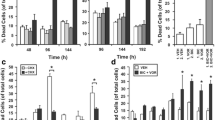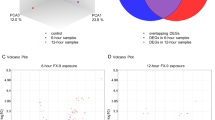Abstract
We report that all-trans retinoic acid (ATRA) in combination with zoledronic acid has strong synergistic cytotoxic and apoptotic effects against human hormone- and drug-refractory prostate cancer cells, PC-3 and DU-145, in a time- and dose-dependent manner. We further investigated the effect of the combination treatment on the apoptotic process by both oligoarray and protein array analysis in DU-145 cells, in which the drug combination shows much more strong synergistic effects, as compared to PC-3 cells. Moreover, we have also performed real time-PCR array analysis to validate oligoarray results. We demonstrated that the combination of ATRA and zoledronic acid is a strong inducer of apoptotic related cell death in human androgen-and drug refractory prostate cancer cells DU-145, at either transcriptional or translational levels. While expression of proapoptotic genes such as tumor necrosis factor receptor superfamily (TNFRSF), Bad, Bax, Fas, FADD are induced with the exposure of the combination, expression of antiapoptotic genes or proteins such as members of inhibitor apoptosis family (IAPs), MCL-1, LTBR, p53 and bcl-2 are reduced. Because this novel combination treatment has fewer side effects than is generally the case with conventional cytotoxic agents, this regimen may be a good option for treatment of elderly prostate cancer patients.







Similar content being viewed by others

References
Jemal A, Siegel R, Ward E, Hao Y, Xu J, Murray T, Thun MJ (2008) Cancer statistics. CA Cancer J Clin 55:10–30
Garnick MB (1997) Hormonal therapy in the management of prostate cancer: from Higgins to the present. Urology 49:5–15
Albertsen PC, Fryback DG, Storere BE (1995) Long term survival among men with conservatively treated localized prostate cancer. J Am Med Assoc 274:626–631
Ashkenazi A, Holland P, Eckhardt (2008) Ligand based ligand-based targeting of apoptosis in cancer: the potential of recombinant human apoptosis ligand 2/tumor necrosis factor-related apoptosis-inducing ligand (rhApo2L/TRAIL). J Clin Oncol 26:3621–3630
Devlin H, Mudryj M (2009) Progression of prostate cancer: multiple pathways to androgen independence. Cancer Lett 274:177–186
Kurie JM, Hong WK (1999) Retinoids as antitumor agents: a new age of biological therapy. Cancer J Sci Am 5:150–151
Lotan R (1996) Retinoids in cancer chemoprevention. FASEB J 10:1031–1039
Lotan Y, Xu XC, Shalev M, Lotan R, Williams R, Wheeler TM, Thompson TC, Kadmon D (2000) Differential expression of nuclear retinoid receptors in normal and malignant prostates. J Clin Oncol 18:116–121
Smith MA, Parkinson DR, Cheson BD, Friedman MA (1992) Retinoids in cancer therapy. J Clin Oncol 10:839–864
Zhang XK (2002) Vitamin A and apoptosis in prostate cancer. Endocr Relat Cancer 9:87–102
Koshiuka K, Elstner E, Williamson E, Said JW, Tada Y, Koeffler HP (2000) Novel therapeutic approach: organic arsenical melarsoprol alone or with all-trans-retinoic acid markedly inhibit growth of human breast and prostate cancer cells in vitro and in vivo. Br J Cancer 82:452–458
Kucukzeybek Y, Gul MK, Cengiz E, Erten C, Karaca B, Gorumlu G, Atmaca H, Uzunoglu S, Karabulut B, Sanli UA, Uslu R (2008) Enhancement of docetaxel-induced cytotoxicity and apoptosis by all-trans retinoic acid (ATRA) through downregulation of survivin (BIRC5), MCL-1 and LTbeta-R in hormone- and drug resistant prostate cancer cell line, DU-145. J Exp Clin Cancer Res 12:27–37
Russell RGG, Rogers MJ (1999) Bisphosphonates: from the laboratory to the clinic and back again. Bone 25:97–106
Green JR (2003) Antitumor effects of bisphosphonates. Cancer 97:840–847
Cengiz E, Karaca B, Kucukzeybek Y, Gorumlu G, Gul MK, Erten C, Atmaca H, Uzunoglu S, Karabulut B, Sanli UA, Uslu R (2010) Overcoming drug resistance in hormone- and drug-refractory prostate cancer cell line, PC-3 by docetaxel and gossypol combination. Mol Biol Rep 37(3):1269–1277. Epub 2009 Mar 14
Zaidman BZ, Wasser SP, Nevo E, Mahajna J (2008) Coprinus comatus and Ganoderma lucidum interfere with androgen receptor function in LNCaP prostate cancer cells. Mol Biol Rep 35(2):107–117. Epub 2007 Mar 13
Chou TC, Talalay P (1984) Quantitative analysis of dose-effect relationships: the combined effects of multiple drugs on enzyme inhibitors. Adv Enzyme Regul 22:27–55
Hsu H, Shu HB, Pan MG, Goeddel DV (1996) TRADD-TRAF2 and TRADD-FADD interactions define two distinct TNF receptor 1 signal transduction pathways. Cell 84:299–306
Muzio M, Chinnaiyan AM, Kischkel FC, O’Rourke K, Shevchenko A, Ni J, Scaffidi C, Bretz JD, Zhang M, Gentz R, Mann M, Krammer PH, Peter ME, Dixit VM (1996) FLICE, a novel FADD-homologous ICE/CED-3-like protease, is recruited to the CD95 (Fas/APO-1) death-inducing signaling complex. Cell 85:817–827
Chopra DP, Menard RE, Januszewski J, Mattingly RR (2004) TNF-α mediated apoptosis in normal human prostate epithelial cells and tumor cell lines. Cancer Lett 203:145–154
Boldin MP, Goncharov TM, Goltsev Y, Wallach D (1996) Involvement of MACH, a novel MORT1/FADD-interacting protease, in Fas/APO-1 and TNF receptor-induced cell death. Cell 85:803–815
Manna SK, Aggarwal BB (2000) All-trans-retinoic acid upregulates TNF receptors and potentiates TNF-induced activation of nuclear factors-κB, activated protein-1 and apoptosis in human lung cancer cells. Oncogene 19:2110–2119
McEleny KR, Watson RWG, Coffey RNT, O’Neill AJ, Fitzpatrick JM (2002) Inhibitors of apoptosis proteins in prostate cancer cell lines. Prostate 51:133–140
Tamm I, Wang Y, Sausville E, Scudiero DA, Vigna N, Oltersdorf T, Reed J (1998) IAP Family protein survivin inhibits caspase activity and apoptosis induced by Fas (CD95), Bax, caspases, and anticancer drugs. Cancer Res 58:5315–5320
Suzuki A, Tsutomi Y, Akahane K, Araki T, Miura M (1998) Resistance to Fas-mediated apoptosis: activation of caspase 3 is regulated by cell cycle regulator p21WAF1 and IAP gene family ILP. Oncogene 17:931–939
Deveraux QL, Roy N, Stennicke HR, Van Arsdale T, Zhou Q, Srinivasula SM, Alnemri ES, Salvesen GS, Reed J (1998) IAPs block apoptotic events induced by caspase-8 and cytochrome c by direct inhibition of distinct caspases. EMBO J 17:2215–2223
Chu ZL, McKinsey TA, Liu L, Gentry JJ, Malim MH, Ballard DW (1997) Suppression of tumour necrosis factor-induced cell death by inhibitor of apoptosis c-IAP2 is under NF-kappa B control. Proc Natl Acad Sci USA 94:10057–10062
Stehlik C, de Martin R, Kumabashiri I, Schmid JA, Binder BR, Lipp J (1998) Nuclear Factor (NF)-kB-regulated X-chromosome linked iap gene expression protects endothelial cells from tumor necrosis factor a-induced apoptosis. J Exp Med 188:211–216
Manji GA, Hozak RR, LaCount DJ, Friesen PD (1997) Baculovirus inhibitor of apoptosis functions at or upstream of the apoptotic suppressor p35 to prevent programmed cell death. J Virol 71:4509–4516
Adida C, Berrebi D, Peuchmaur M, Reyes-Mugica M, Altieri DC (1998) Anti-apoptosis gene, survivin, and prognosis of neuroblastoma. Lancet 351:882–883
Monzo M, Rosell R, Felip E, Astudillo J, Sanchez JJ, Maestre J et al (1999) A novel anti-apoptosis gene: re-expression of survivin messenger RNA as a prognosis marker in non-small-cell lung cancers. J Clin Oncol 17:2100–2104
Sarela AI, Macadam RC, Farmery SM, Markham AF, Guillou PJ (2000) Expression of the antiapoptosis gene, survivin, predicts death from recurrent colorectal carcinoma. Gut 46:645–650
Tanaka K, Iwamoto S, Gon G, Nohara T, Iwamoto M, Tanigawa N (2000) Expression of survivin and its relationship to loss of apoptosis in breast carcinomas. Clin Cancer Res 6:127–134
Kato J, Kuwabara Y, Mitani M, Shinoda N, Sato A, Toyama T et al (2001) Expression of survivin in esophageal cancer: correlation with the prognosis and response to chemotherapy. Int J Cancer 95:92–95
Aichberger KJ, Mayerhofer M, Gleixner KV, Krauth MT, Gruze A, Pickl WF et al (2007) Identification of MCL1 as a novel target in neoplastic mast cells in systemic mastocytosis: inhibition of mast cell survival by MCL1 antisense oligonucleotides and synergism with PKC412. Blood 109:3031–3041
gli-Esposti MA, vis-Smith T, Din WS, Smolak PJ, Goodwin RG, Smith CA (1997) Activation of the lymphotoxin beta receptor by cross-linking induces chemokine production and growth arrest in A375 melanoma cells. J Immunol 158:1756–1762
Lukashev M, LePage D, Wilson C, Bailly V, Garber E, Lukashin A et al (2006) Targeting the lymphotoxin-beta receptor with agonist antibodies as a potential cancer therapy. Cancer Res 66:9617–9624
Winter H, van den Engel NK, Poehlein CH, Hatz RA, Fox BA, Hu HM (2007) Tumor-specific T cells signal tumor destruction via the lymphotoxin beta receptor. J Transl Med 5:14–26
Zhao M, Begum S, Ha PK, Westra W, Califano J (2008) Downregulation of rad17 in head and neck cancer. Head&Neck 30:35–42
Author information
Authors and Affiliations
Corresponding author
Electronic supplementary material
Rights and permissions
About this article
Cite this article
Karabulut, B., Karaca, B., Atmaca, H. et al. Regulation of apoptosis-related molecules by synergistic combination of all-trans retinoic acid and zoledronic acid in hormone-refractory prostate cancer cell lines. Mol Biol Rep 38, 249–259 (2011). https://doi.org/10.1007/s11033-010-0102-6
Received:
Accepted:
Published:
Issue Date:
DOI: https://doi.org/10.1007/s11033-010-0102-6



